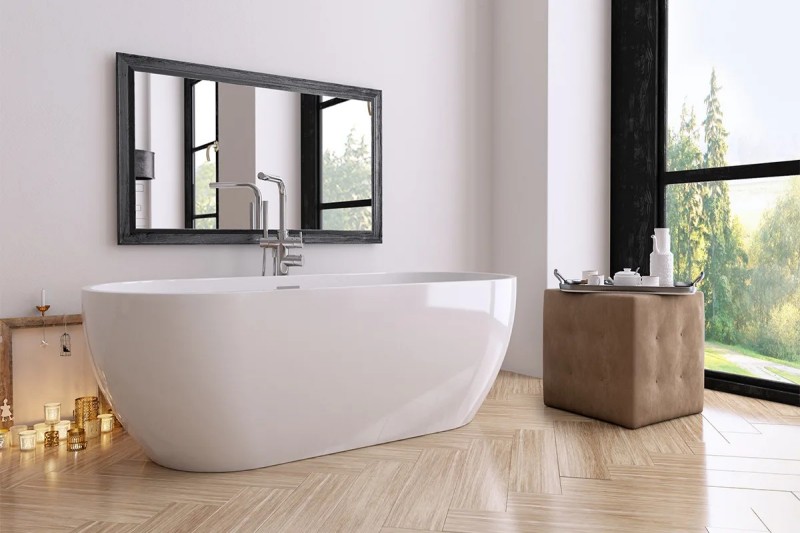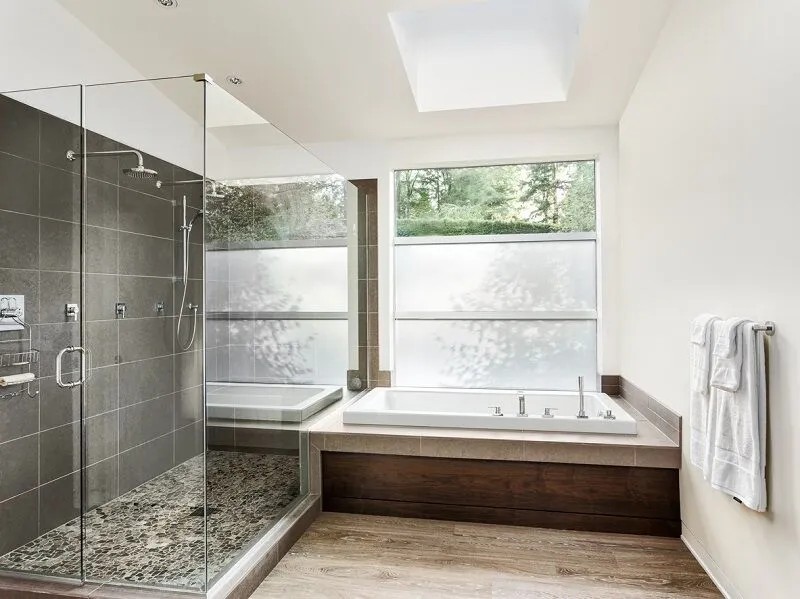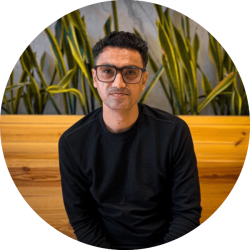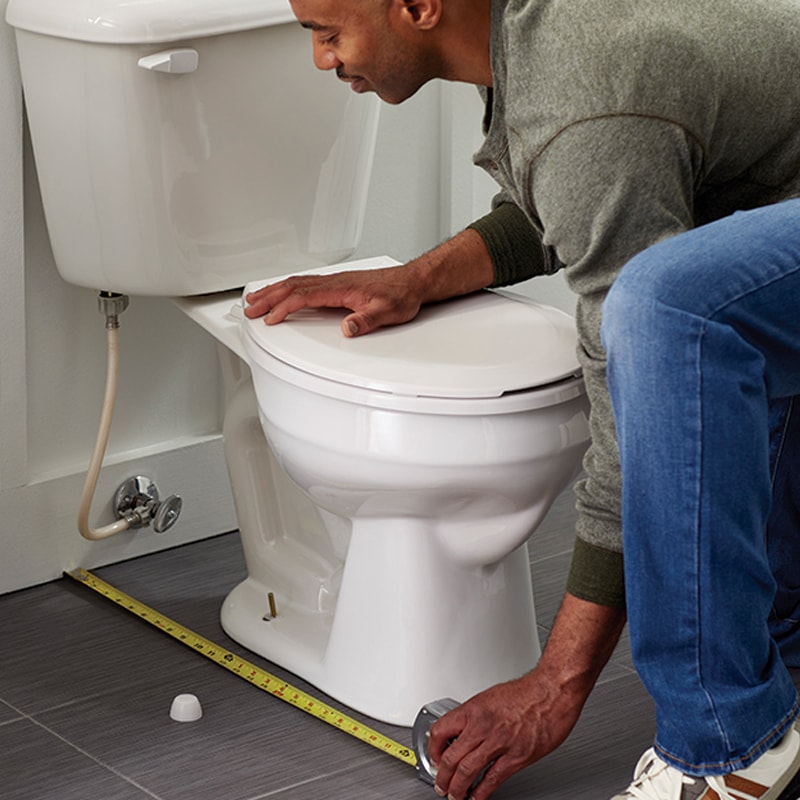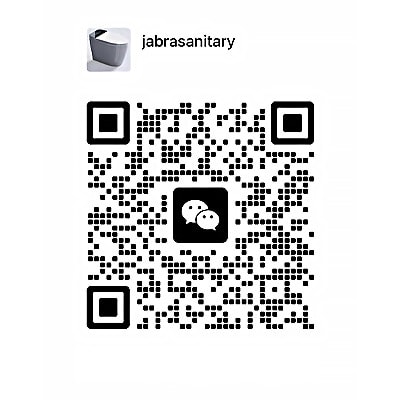 English
English
Jabra Sanitary is a sanitaryware supplier offering toilets, sinks, faucets, bathtubs, etc., at competitive prices. If you're a distributor, wholesaler, or project contractor, get a quote today!
 $23.9 Limited-time Offer
$23.9 Limited-time Offer Consignment Policy
Consignment Policy 20 Years of Experience
20 Years of Experience
Choosing the right bathtub material can significantly impact your bathroom's functionality, aesthetics, and overall value. In 2025, the porcelain vs acrylic tubs comparison remains relevant, as each material offers unique benefits and drawbacks.
In this guide, we'll explore the main differences between porcelain and acrylic bathtubs, covering everything from durability and heat retention to cost and maintenance requirements. By understanding these factors, you can make a well-informed choice that suits your lifestyle, budget, and design preferences.
Table of Contents
What is an Acrylic Bathtub?
What is a Porcelain Tub?
Main Differences Between Acrylic and Porcelain Bathtubs
Porcelain vs. Acrylic Bathtub Comparison 2025
Porcelain or Acrylic Tub, The Comparison Table
FAQs
Acrylic vs Porcelain Bathtub: Which is the Better Material?
Final Thoughts
What is an Acrylic Bathtub?
An acrylic bathtub is constructed with a layer of acrylic material applied over a fiberglass structure. Known for its lightweight and flexible nature, acrylic bathtubs are a popular choice in modern bathrooms.
Acrylic tubs are available in a variety of shapes, sizes, and styles, making them versatile and suitable for different design aesthetics.
Because acrylic is a non-porous material, it's highly resistant to mildew, mold, and stains, adding to its appeal for low-maintenance bathrooms. This makes them one of the best materials for soaking tubs in terms of convenience and comfort when comparing fiberglass vs porcelain tubs.
Pros of Acrylic: Lightweight, heat-retaining, cost-effective, and highly customizable.
Cons of Acrylic: Prone to scratching and may fade over time with prolonged exposure to sunlight.
What is a Porcelain Tub?
A porcelain bathtub, also called a porcelain enameled steel bathtub, is typically constructed with a base of iron or steel, coated with a layer of porcelain enamel.
This creates a hard, glossy surface that is both durable and visually appealing. Porcelain bathtubs are highly resistant to scratches and retain their shine for decades with proper care.
However, they tend to be heavier than acrylic tubs, making installation more complex and sometimes more expensive. Porcelain tubs are often found in classic or vintage-style bathrooms, contributing to a timeless and elegant look.
Pros of Porcelain: Scratch-resistant, classic aesthetic, retains shine over time.
Cons of Porcelain: Heavier, more costly, and can chip or crack if struck with hard objects.
Main Differences Between Acrylic and Porcelain Bathtubs
For the main differences between porcelain enameled steel bathtub vs acrylic, Porcelain is harder than acrylic, thanks to its enamel coating over metal, which makes it more resistant to impact and scratches.
Acrylic, while softer, is flexible and less likely to crack under pressure. This difference between acrylic bathtubs vs porcelain in hardness impacts the durability and maintenance needs of each type of bathtub.
Porcelain vs. Acrylic Bathtub Comparison 2025
Choosing the right bathtub material can significantly impact your bathroom's functionality, aesthetics, and overall value.
In 2025, the debate between porcelain bathtubs vs acrylic remains relevant, as each material offers unique benefits and drawbacks.
While porcelain is a harder and more durable material, acrylic offers more flexibility and ease of maintenance, making it a popular choice in modern bathrooms.
Durability
Porcelain bathtubs are renowned for their long lifespan, often lasting several decades with minimal wear. They resist chipping and maintain their glossy finish over time, making them ideal for those seeking a durable investment.
In contrast, acrylic bathtubs, while generally durable, may be more susceptible to surface scratches and require extra care to maintain their appearance. Both materials are resistant to stains, but porcelain's hardness gives it an edge in resilience against everyday wear and tear.
Heat Retention
Acrylic bathtubs generally retain heat better than porcelain, allowing for a warm and comfortable bathing experience. This is due to acrylic's insulating properties, which help keep the water warmer for longer periods.
Porcelain tubs, on the other hand, tend to cool down faster, requiring more hot water to maintain warmth. For users who enjoy extended soaks, acrylic may be the more comfortable choice.
Popularity and Resale Value
When it comes to popularity and resale value, both porcelain and acrylic bathtubs have their strong points.
Acrylic bathtubs are highly popular in modern home designs due to their variety in styles, shapes, and affordability. This appeal often enhances the resale value in homes with contemporary bathrooms.
Porcelain bathtubs, however, tend to be more favored in traditional or luxury settings. The classic, glossy look of porcelain can add a timeless quality to a home, potentially increasing resale value for certain buyers who prefer this elegant style.
Restoration and Repair
Restoring and repairing porcelain and acrylic bathtubs require different approaches and costs. Porcelain bathtubs can be refinished by applying a new layer of enamel, but this process can be costly and requires professional help.
Acrylic bathtubs, on the other hand, are generally easier to repair, as minor scratches can often be buffed out or treated with an acrylic repair kit. While both materials can be restored to maintain a fresh appearance, acrylic repairs are typically simpler and less expensive than porcelain refinishing.
Weight
One of the significant differences between acrylic and porcelain bathtubs is their weight. Porcelain tubs, with their metal base, are considerably heavier than acrylic tubs.
On average, a porcelain tub can weigh between 200 to 400 pounds, while acrylic tubs are much lighter, averaging around 70 to 100 pounds.
This weight difference has practical implications for installation: acrylic tubs are easier to handle and may not require reinforced flooring, making them a more convenient choice for upstairs bathrooms.
The added weight of porcelain can provide a more substantial feel but also increases installation complexity and potentially the overall cost.
Cost Comparison
The cost of acrylic and porcelain bathtubs varies significantly, with acrylic generally being the more budget-friendly option.
Acrylic tubs typically range from $300 to $1,000, depending on the model and brand, making them accessible for a range of budgets.
Porcelain tubs, however, are priced higher, with basic models starting around $400 and going up to $2,000 or more for high-end designs. The higher cost of porcelain reflects its durability and classic appeal, but it may not be the ideal choice for those working within a tighter budget.
When considering long-term costs, it's also essential to factor in the maintenance and potential restoration expenses of each material.
Installation Process
Installing an acrylic tub is generally more straightforward than installing a porcelain tub, largely due to weight.
Acrylic's lighter weight makes it easier to maneuver into place, which can reduce installation time and labor costs. Porcelain tubs, being much heavier, may require reinforced flooring and extra labor, particularly for upper-floor bathrooms.
As a result, porcelain tub installations may incur additional expenses and longer setup times. Both materials benefit from professional installation, but for homeowners seeking a more straightforward process, acrylic has the advantage.
Maintenance Requirements
Both porcelain and acrylic bathtubs are relatively low-maintenance, but each has its unique care requirements.
Acrylic tubs are easy to clean with non-abrasive cleaners, and their non-porous surface helps resist mildew and mold. However, acrylic is more prone to scratches, so avoiding harsh scrubbers is essential.
Porcelain, while resistant to scratches, can chip if hit with heavy objects and may require enamel refinishing over time to maintain its shine.
Gentle cleaning products are ideal for both materials, but porcelain's tougher surface allows for slightly more abrasive cleaners, making it a bit easier to keep looking pristine over the years.
Stain Resistance and Removal
Stain resistance is an important consideration for any bathtub material, especially in homes with high water usage or exposure to products that could discolor the tub surface.
Acrylic bathtubs are naturally resistant to staining due to their non-porous surface, making them easy to clean and maintain with mild cleaners. However, they can absorb stains over time if exposed to harsh chemicals or dyes.
Porcelain tubs, on the other hand, are also resistant to stains but can be more challenging to clean if discoloration occurs, especially if the enamel coating has worn thin.
Gentle cleaning products and regular maintenance can help keep both types of tubs free from stains, though acrylic tends to have a slight edge in ease of stain removal.
Porcelain or Acrylic Tub, The Comparison Table
Feature |
Acrylic Bathtub |
Porcelain Bathtub |
|---|---|---|
Durability |
Prone to scratches, but resilient with care |
Very durable, but may chip with heavy impact |
Heat Retention |
Good heat retention, ideal for soaking |
Cooler requires more hot water for long baths |
Popularity and Resale Value |
Popular in modern homes, good resale value |
Favored for traditional bathrooms, high resale appeal |
Restoration |
Easy to repair minor scratches |
Refinishing can be costly |
Weight |
Lightweight (70-100 lbs) |
Heavy (200-400 lbs) |
Cost |
Affordable ($300-$1,000) |
Higher cost ($400-$2,000+) |
Installation |
Easy to install |
Requires reinforced flooring |
Maintenance |
Low maintenance, non-porous surface |
More maintenance can chip over time |
Stain Removal |
Easy, non-porous surface |
Requires regular cleaning, enamel wear can affect stain resistance |
FAQs
Is a fiberglass tub lighter than an acrylic tub?
Yes, fiberglass tubs are typically lighter than acrylic tubs, making them easy to maneuver during installation. However, they may not be as durable or heat-retentive as acrylic tubs.
How long do acrylic tubs last?
With proper care, acrylic tubs can last 10 to 15 years or more. Regular cleaning and avoiding abrasive tools will help maintain their appearance and extend their lifespan.
Do acrylic bathtubs turn yellow over time?
Over time, some acrylic tubs may develop a yellowish tint, particularly if exposed to harsh chemicals or UV light. Regular cleaning and using gentle, non-abrasive cleaners can help prevent yellowing.
How can you tell if your tub is porcelain or enamel?
To determine if your tub is porcelain or enamel, place a magnet on its surface. Porcelain tubs typically have a cast iron or steel base and will attract the magnet, while acrylic or fiberglass tubs will not.
How to determine what your bathtub is made of?
To identify your bathtub's material, consider its weight, appearance, and texture. Acrylic tubs are lightweight with a warm, smooth feel, while porcelain tubs are heavier with a cooler, glossy finish. You can also consult a professional for precise identification.
Acrylic vs Porcelain Bathtub: Which is the Better Material?
Determining Your Bathroom Style
Choosing between acrylic and porcelain depends greatly on your bathroom's style.
Acrylic tubs offer a sleek, modern look with versatile shapes and sizes, fitting well in contemporary bathrooms. Porcelain, however, exudes a classic elegance that suits traditional and vintage-themed bathrooms.
Consider the aesthetic you want to create, as this choice will impact the overall ambiance of your space.
Assessing Your Needs
Evaluate your needs in terms of durability, maintenance, and how often the tub will be used.
Acrylic is more forgiving when it comes to minor wear and tear and easier to repair, while porcelain offers exceptional durability and a timeless look. For households with children or pets, acrylic might be preferable due to its resilience and ease of maintenance.
Budget Considerations
If you're working within a budget, acrylic is generally the more affordable option. However, if you're looking for a long-term investment and a classic appearance, porcelain may justify its higher upfront cost.
Both materials have different long-term expenses as well—acrylic may need minor repairs, while porcelain might require occasional refinishing.
Consulting a Professional
For a new bathroom installation or remodel, consulting a professional can be invaluable. They can provide tailored advice on which material best suits your bathroom layout, aesthetic goals, and budget.
Professionals can also assess whether your flooring can support a heavy porcelain tub if that's your choice.
Jabra Sanitary has extensive experience with high-quality bathtub manufacturing. Welcome to contact us and we are always happy to help you make the right choice for your bathroom.
Final Thoughts
Are acrylic bathtubs good? Both acrylic and porcelain bathtubs have unique strengths, and the right choice depends on your personal preferences and practical needs.
While there is no single bathtub material, acrylic or porcelain bathtub, that stands out as superior in every aspect.
Acrylic often wins for its flexibility, affordability, and ease of maintenance, especially in modern settings. However, if classic appeal, durability, and a substantial feel are high on your list, a porcelain tub may be the better choice.
When making your decision on acrylic tubs vs porcelain, take into account factors like durability, maintenance, and design preferences. Jabra Sanitary is a leading bathtub manufacturer, offering a wide range of tubs in various materials to suit every bathroom style and need.








